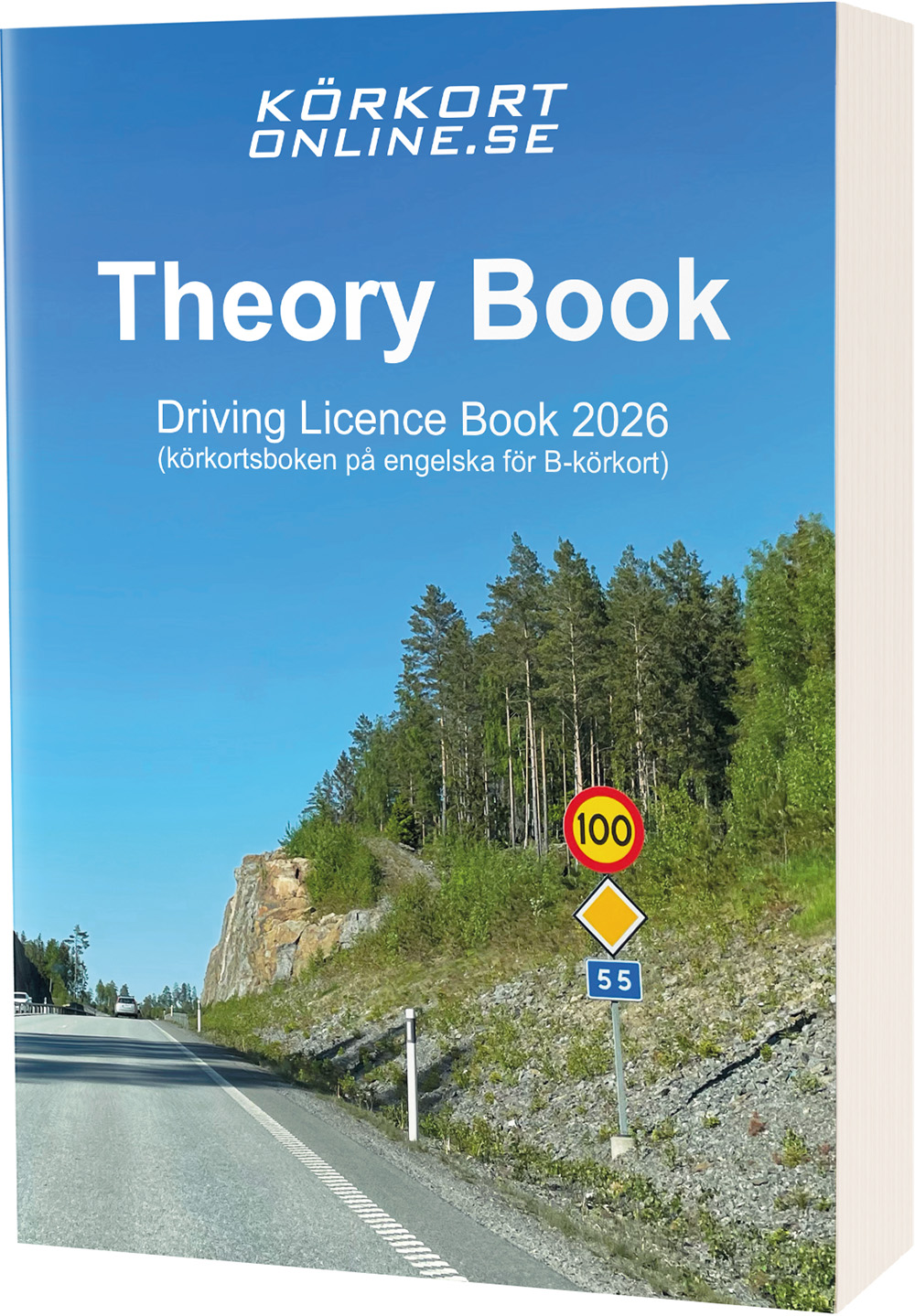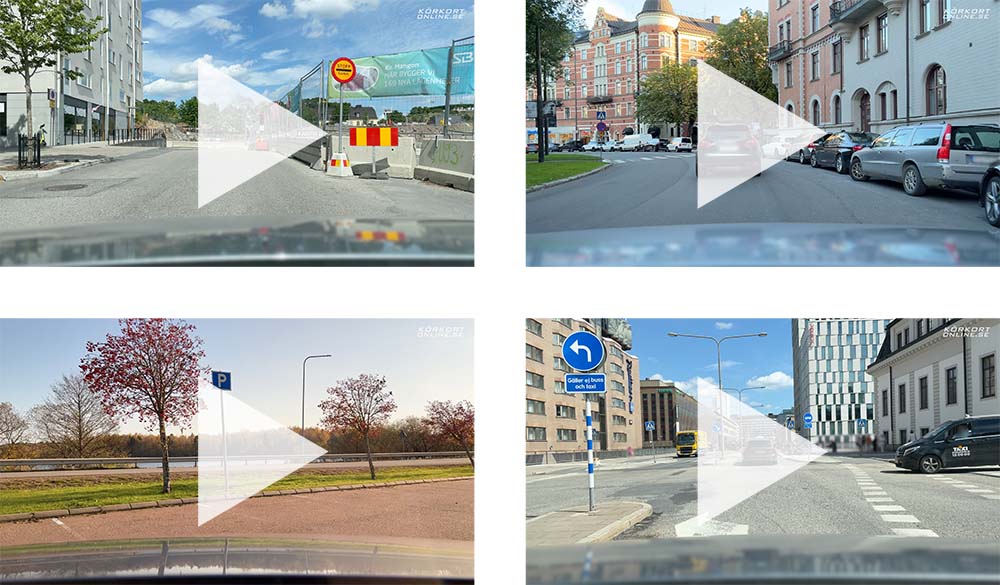Pedestrian crossings, bicycle crossings & bicycle path
Pedestrian crossing
A pedestrian crossing is always indicated by the sign and/or road marking for pedestrian crossing. In addition to those walking, pedestrians also include:
- Persons in wheelchairs (including electric wheelchairs).
- Persons on roller skates, roller skis, kicksleds, toy vehicles and similar.
- Persons who walk with a bicycle/moped (i.e. not cycling/driving).
The easiest way to avoid misunderstandings and accidents is to seek eye contact with the pedestrians. However, you should not wave the pedestrian over, as this creates a false sense of security, especially if there are multiple lanes in the same direction. If you wave them over, the pedestrian will perhaps relax and assume that the whole road is clear, although a car could be approaching fast from another lane with no intention of stopping.
Controlled pedestrian crossings
- Have functioning traffic signals (or a police officer).
- Both drivers and pedestrians shall respect the traffic signals. Sometimes pedestrians do not make it across before their light turns red. If they entered the pedestrian crossing when they had a green light, you must let them pass before you can drive.
Uncontrolled pedestrian crossings
- Drivers have an obligation to give way to pedestrians who have stepped out onto the pedestrian crossing or who are about to do so. Drivers who have an obligation to give way must clearly show their intent to do so by, in good time, reducing their speed or stopping.
An uncontrolled pedestrian crossing. You have an obligation to give way to the pedestrian, as he is just about to step out onto the pedestrian crossing.
This is a tricky pedestrian crossing. There are traffic signals, but they are not functioning. This means that the pedestrian crossing is uncontrolled.
Footpath
- A footpath (sidewalk/pavement) is a path for pedestrians. Drivers are only allowed to cross the footpath.
- Drivers have an obligation to give way to pedestrians on the footpath.
- Lacks a standardised design. Is sometimes (but not always) marked with the Footpath sign.
- Crossing a footpath on a normal road for car traffic is rare, as such a road design would be dangerous for pedestrians. Footpaths are often crossed when entering/exiting a property.

This is a junction for normal car traffic. The design of the junction (e.g. the road surface and lack of raised ground) makes it clear that the footpath does not cross the road. Pedestrians coming from the footpath (red arrows) may only cross the road if it is possible to do so without causing a hazard or an obstruction to traffic. However, be careful and keep in mind that pedestrians are unprotected road users.
If you enter/exit the property marked by the red arrow, you will cross a footpath. You have an obligation to give way to pedestrians on the footpath.
This is a place designed to make it easier for pedestrians to cross the road. However, the footpath does not cross the road, and there is no pedestrian crossing. Even though car traffic is prioritised here, you should keep in mind that pedestrians are unprotected road users.
Bicycle passages
- Always indicated by the road marking for bicycle passage.
- Bicycle passages are often combined with pedestrian crossings.
Controlled bicycle passages
- Have functioning traffic signals (or a police officer).
- Both drivers and cyclists shall respect the traffic signals. Sometimes cyclists do not make it across before their light turns red. If they entered the bicycle passage when they had a green light, you must let them pass before you can drive.
Uncontrolled bicycle passages
- When you are driving and approach an uncontrolled bicycle passage, you must adapt your speed so that you do not endanger those on the bicycle passage.
- If you are crossing an uncontrolled bicycle passage while turning or exiting a roundabout, you must drive at low speed and provide any cyclists who are already on or are just about to enter the bicycle passage with the opportunity to pass.
- Cyclists have an obligation to give way to car drivers. Cyclists must reduce their speed and they may only cross the road if it can be done without danger.
Clarification about bicycle passages
Some words used in connection with uncontrolled bicycle passages may seem unclear (“adapt your speed”, “not endanger”, “opportunity to pass”). The lawmakers want to avoid saying that car drivers have an obligation to give way, as this could give the cyclists a false sense of safety. The fact that car drivers and cyclists have far-reaching obligations towards each other is intended to increase safety. As a car driver, you should keep in mind that the purpose of bicycle passages is to allow cyclists to cross the road. You should also keep in mind that cyclists are unprotected road users. Allowing cyclists to pass is a good and safe habit.
The information concerning cyclists in the sections on bicycle passages, bicycle crossings and bicycle paths also applies to riders of electric scooters and class II mopeds.
An uncontrolled bicycle passage combined with a pedestrian crossing. Adapt your speed so that you do not endanger those on the bicycle passage.
If you turn right, you will cross an uncontrolled bicycle passage. Because you are turning, you have a greater obligation towards cyclists. Reduce your speed and give cyclists an opportunity to pass.
Bicycle crossings

Give way line
(for car traffic)
- A bicycle crossing is always indicated by the road sign for bicycle crossing, the road marking for bicycle crossing, and a give way line for the cars.
- When driving, you have an obligation to give way to cyclists who are using the bicycle crossing or are about to use it.
- The traffic environment around a bicycle crossing is supposed to be designed in a way that makes it inappropriate to drive faster than 30 km/h – for example, by locating the bicycle crossing on a raised hump.
You are approaching a bicycle crossing. You have an obligation to give way to cyclists.
Bicycle paths
- A road or part of a road intended for bicycle traffic. Other drivers are only allowed to cross the bicycle path.
- Car drivers have an obligation to give way to cyclists on the bicycle path.
Clarification about crossing a bicycle path
One problem is that, in a legal sense, the bicycle path does not usually cross the road on which the cars are driving. The fact that mandatory signs for bicycle path displayed on each side of the road does not automatically mean that the bicycle path crosses the road. Most of the time, the bicycle path ends before the road crossing and begins again on the other side. It is unusual that an uninterrupted bicycle path crosses a road intended for cars.
Also note that a bicycle passage or a bicycle crossing always means that the bicycle path is interrupted. In other words, if you see the road marking for bicycle passage/crossing, you can be sure that the bicycle path ends before the junction.
How can I know if I am crossing an uninterrupted bicycle path?
– Unfortunately, it is very difficult to know, as an uninterrupted bicycle path lacks a standardised design. If you ask the experts at the Swedish Transport Agency, they will refer you to the municipality’s detailed plan.
Am I supposed to stop and check the municipality’s detailed plan at every junction?
– No, the best thing to do is to act in the safest manner. Reduce your speed, and allow the cyclists to cross the road.
If you turn right at the red arrow, you will cross a bicycle path according to the municipality’s detailed plan. You have an obligation to give way to cyclists. Note that this is a small entry road. It is not a regular junction.

At this junction, the municipality says that the bicycle path ends at A and starts again at B. In other words, the bicycle path is interrupted and does not cross the road.
Latest forum posts
- << Priority rules
- Pedestrian crossing etc. ↑↑
- Roundabout >>











